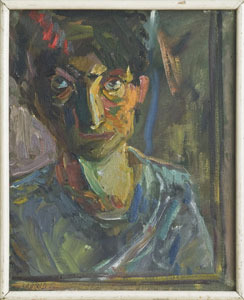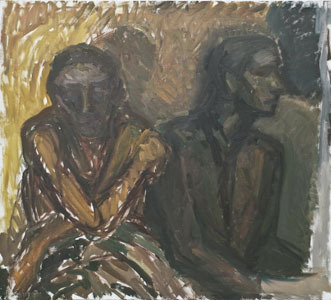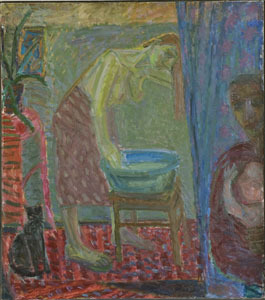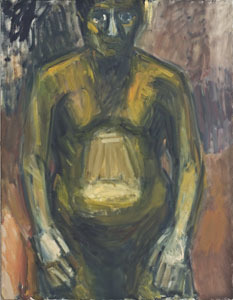TO SURVIVE WITH BRUSHES IN HAND 0
Rasa Andriušytė
www.kamane.lt, 2009 09 25
E.Velaniškytė. “Self-portrait”
E.Velaniškytė. “Self-portrait”
In brief: By organizing an exhibition at Antanas Žmuidzinavičius Museum in Kaunas, the painter Eglė Velaniškytė is returning to the Lithuanian art again. She is returning with features that were the most valuable in her paintings earlier and that are important and interesting in art now: with themes of close relations among people, love, femininity, with the ability to turn the painting surface into the deep truth of life.
After graduating from Vilnius Art Institute in 1982, the painter E.Velaniškytė was one of the most outstanding young Kaunas painters in the 9th decade. After the period of work at a secondary school and after organizing two personal exhibitions, she left the city in spring of 1985 and became a country-side dweller in North Lithuania. After abandoning the Soviet Kaunas which made the soul freeze, the painter states to have experienced “five golden years” in Sabalunkai homestead. The painting “Three Waiting Women” presented in the exhibition is the reflection of this fruitful period.
E.Velaniškytė. “Three Women” E.Velaniškytė. “Everything about a Woman” E.Velaniškytė. “Sleeping Boy or St. John’s Dream”. 2006
The exhibition of E.Velaniškytė open at the moment is called “Waiting for a Painting. Everything about a Woman”. After almost 25 years, the dweller of Sabalunkai village became a wife, a mother, a village teacher and a city painter again. She finds numerous themes, plots and heroes in the variety of her social roles.
E.Velaniškytė. “Teenager’s Mother”. 2008
It was easier to come back to the city with all burden and happiness of woman’s life than to take a brush to the hands again. The art environment and atmosphere of creation has changed much in Kaunas. The paintings of E.Velaniškytė are not contemporary. Colours do not dazzle the eyes, she uses no irony, does not invite into discussion, she does not care for global themes. On the contrary, looking at her works, the viewer has to lock the glance for a long period of time. One should not rush and take time to study the painting and feelings of the artist.
E.Velaniškytė. “Ward No. 6”. 2008
The old method of looking at art is typical of E.Velaniškytė’s paintings: the author tells the story, the viewer listens. First the eye is caught by the velvet darkness of her beloved colours, deep shades, vibrating space and the rather heavy and harsh shapes of people and things. The painter constructs the figures and faces academically correctly, she models bodies by colours and shades sensitively.
There is no distance between the artist and the world pictured by her at all – it is one more non-contemporary feature of her works. She simply lives in the daily situations rather than studies or watches them. Reality and daily life in E.Velaniškytė’s works is not banal – these are very serious topics of painting rendered in strokes of a professional. It is the exceptional feature of this artist.
E.Velaniškytė. “Sunday”. 1983, home
It is the world of painting in which the burden of human life and its meanings open up. Everything is deep and serious: sleep (“Sleeping Boy or St. John’s Sleep”, 2006), observing one’s body (“Woman in the Bath”, 2009), sitting at a table, which becomes a sacral drama (“Last Supper. Apostle. 2009). The paintings of E.Velaniškytė spread the important message to the contemporary man that there are some lasting things which should not be changed in life, even though they are sometimes depressing and hard to bear. Hard situations are sublimated in dark paintings; hardships are regarded with dignity (“Teenager’s Mother”, 2008). Heroines of her paintings have features of self-portrait. They reflect and know the truths for which one should live.
The intimate and subjective relation with reality is the exceptional feature of E.Velaniškytė’s paintings. The intensive, subjective and emotional relation with reality was typical of painters of her generation, the young generation of the 9th decade. As many of these painters hid their faces under the mask of post-modernism, the painter E.Velaniškytė enriches Kaunas space of painting by the purity, clear and open, often painful relation with the reality.
Pain, disease, sense of death are frequent themes in E.Velaniškytė’s works. (“A Ward for Two”, 2007, “A Man and his Pit”, 2009). Still, the attitude of Eglė is not desperate. E.Velaniškytė paints figures in brownish, greenish and black shades as if looking for reconciliation with the hardship.
E.Velaniškytė’s works remind of paintings of Vincentas Gečas and Arvydas Šaltenis. Similar to the former teachers, she never avoids real situations. The self-portraits and compositions of E.Velaniškytė on the theme of hospital (“Ward No. 6”, 2008) remind of early paintings of V.Gečas “A Girl”, “Family Portrait” (both created in 1962) by the loneliness and mood of comfortless waiting. The importance of feeling relates E.Velaniškytė’s works with A.Šaltenis’ paintings.
E.Velaniškytė. “Exercise”. 2008
Colour, facture, stroke are still the main elements used by the painter E.Velaniškytė. Eglė is a modernist. She should not be anybody else. One of the main values of Lithuanian modern painting has not disappeared from her works until now – it is the search for aesthetically valuable and meaningful artistic form. The special colours and pictured scenes, their sacredness distinguishes the artist from other present painters of Kaunas. Portrait, still-life, figure composition – it is the traditional arena of plastic innovations of modern art and the creative activity field of the artist. She may plough and sow in this field as she still has the professional mastery; and the past years, even the ones without canvas and paint, have enriched the artist a lot.












